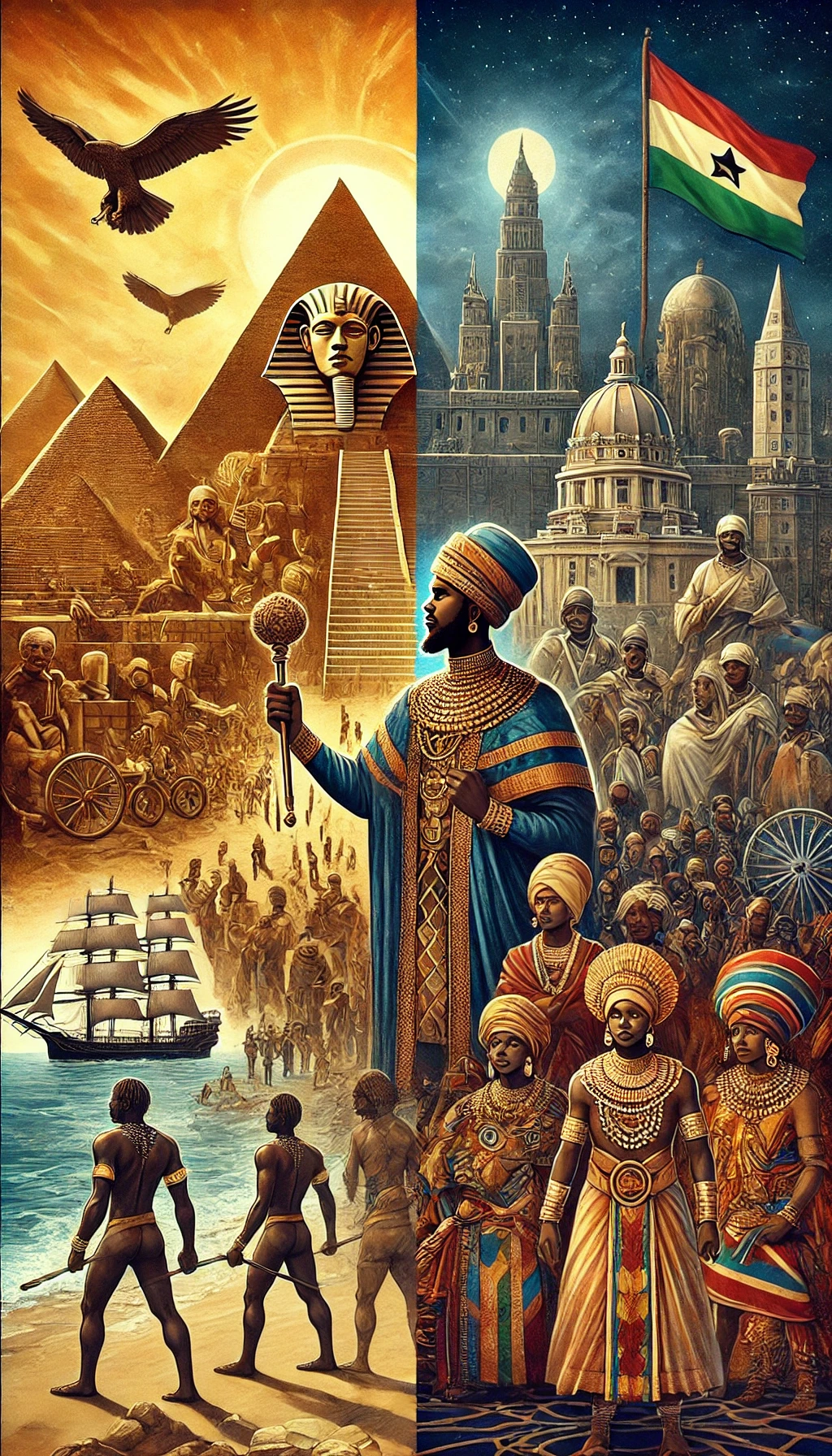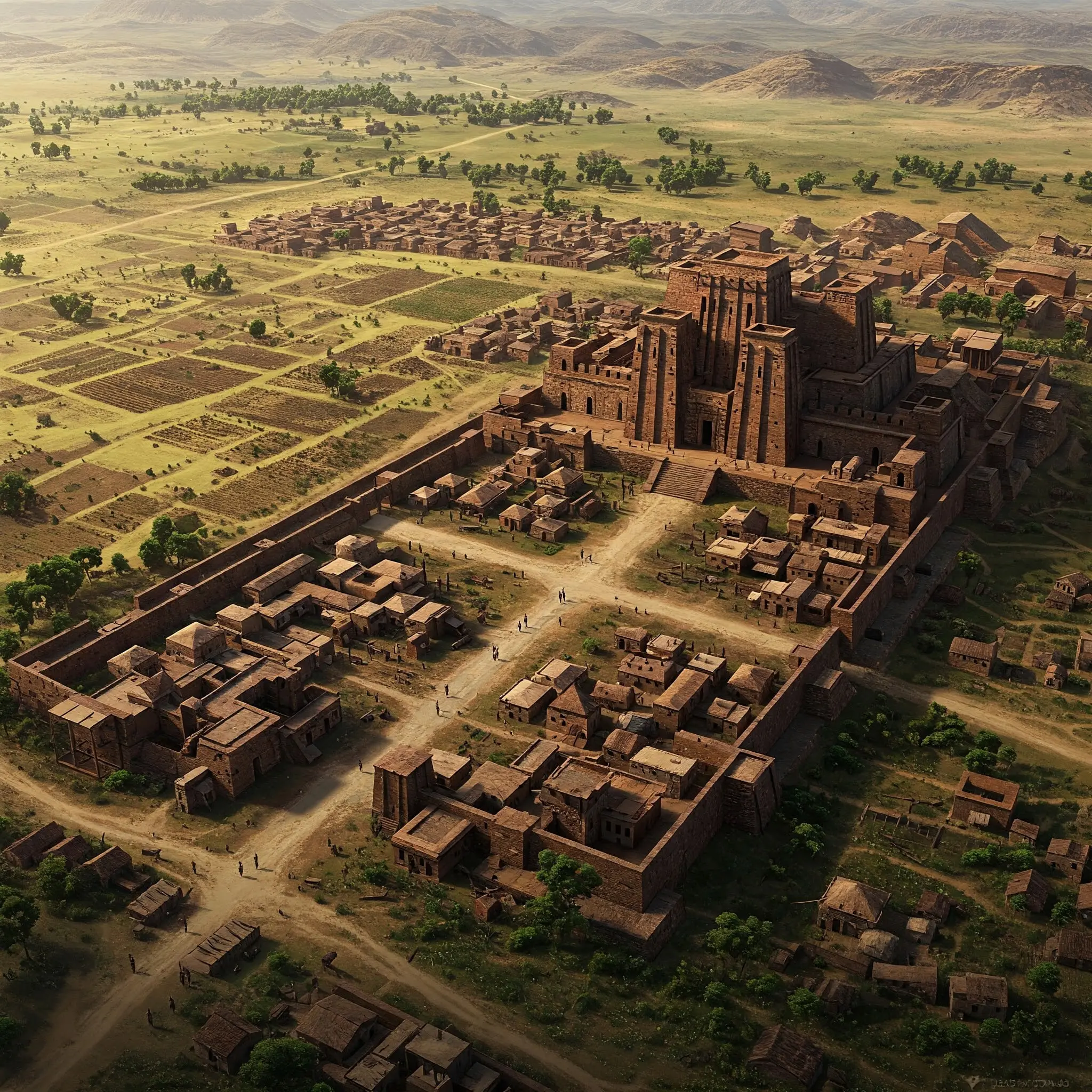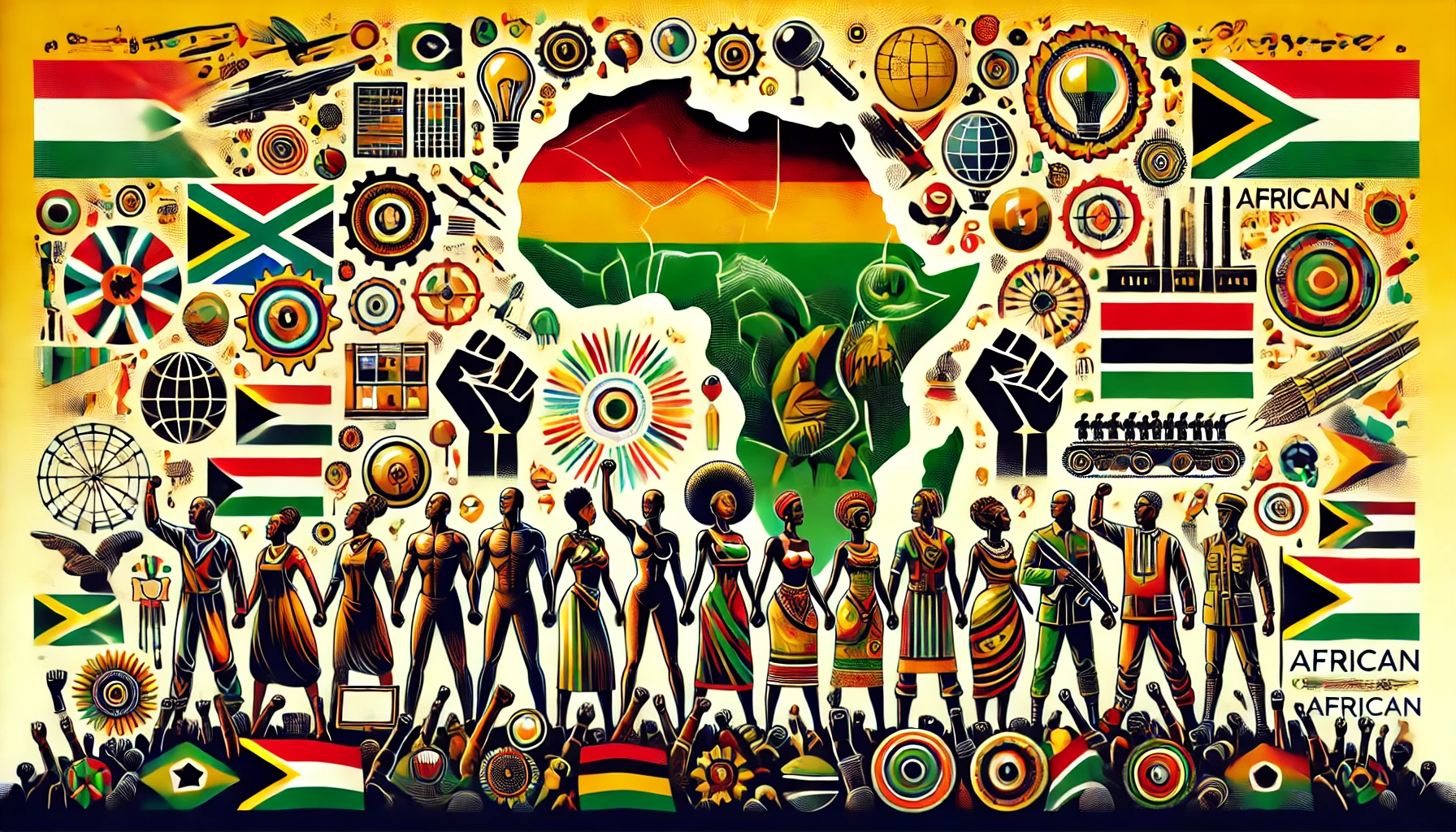1. Ancient Egypt (c. 3100 BCE–30 BCE)
• Historical Location: Northeastern Africa, along the Nile River.
• Present-Day Location: Egypt and parts of northern Sudan.
• Overview: Renowned for its pyramids, hieroglyphics, and advanced civilization, Ancient Egypt laid the groundwork for governance, engineering, and scientific inquiry. It was a dominant cultural and political force for thousands of years.
2. Kingdom of Kush (c. 2500 BCE–300 CE)
• Historical Location: South of Egypt, in the Nubian region.
• Present-Day Location: Northern Sudan.
• Overview: Known for its ironworking and majestic pyramids, Kush often rivaled Egypt in power and influence. Its capital, Meroë, was a hub of culture, trade, and innovation.
3. Carthage (c. 814 BCE–146 BCE)
• Historical Location: The Mediterranean coast of North Africa.
• Present-Day Location: Tunisia.
• Overview: Carthage was a maritime and commercial powerhouse with far-reaching trade networks. Its legacy is entwined with its wars against Rome and contributions to naval technology.
4. Aksum Empire (100 CE–940 CE)
• Historical Location: Horn of Africa, near the Red Sea.
• Present-Day Location: Ethiopia and Eritrea.
• Overview: Aksum was a vital trade hub and one of the first African empires to adopt Christianity. Its architectural feats, such as stelae and obelisks, are iconic symbols of its rich history.
5. Ghana Empire (c. 300 CE–1200 CE)
• Historical Location: Western Africa, between the Senegal and Niger rivers.
• Present-Day Location: Mauritania, Mali, and Senegal.
• Overview: Known as the "Land of Gold," Ghana was a major center for trade in gold and salt. It established powerful connections with North Africa through Trans-Saharan trade routes.
6. Mali Empire (c. 1235–1600 CE)
• Historical Location: West Africa, spreading from the Niger River to the Atlantic Ocean.
• Present-Day Location: Mali, Guinea, Senegal, and Ivory Coast.
• Overview: Under rulers like Mansa Musa, Mali became a beacon of wealth, education, and culture. Timbuktu, its cultural hub, was home to libraries and universities.
7. Songhai Empire (c. 1464–1591 CE)
• Historical Location: West Africa, near the Niger River bend.
• Present-Day Location: Mali, Niger, Nigeria, and parts of Burkina Faso.
• Overview: Following Mali's decline, Songhai rose to prominence. It boasted vast territories, efficient administration, and thriving trade networks.
8. Great Zimbabwe (c. 11th–15th Century CE)
• Historical Location: Southern Africa, inland from the Indian Ocean.
• Present-Day Location: Zimbabwe.
• Overview: Great Zimbabwe is famous for its grand stone architecture and role in trade networks connecting the interior of Africa to the Swahili Coast.
9. Benin Kingdom (c. 1180–1897 CE)
• Historical Location: West Africa, near the Niger River delta.
• Present-Day Location: Nigeria.
• Overview: The Benin Kingdom is renowned for its artistry, especially the Benin Bronzes, and its strong centralized governance.
10. Ashanti Empire (c. 1670–1901 CE)
• Historical Location: West Africa, within the forest region.
• Present-Day Location: Ghana.
• Overview: Known for its wealth in gold and resistance to colonialism, the Ashanti Empire developed a sophisticated political system and rich cultural traditions.
11. Kingdom of Kongo (c. 1390–1857 CE)
• Historical Location: Central Africa, near the Congo River.
• Present-Day Location: Angola, Republic of Congo, and Democratic Republic of Congo.
• Overview: The Kongo Kingdom was a well-organized state known for its trade networks and early Christian influences.
12. Swahili City-States (c. 10th–16th Century CE)
• Historical Location: Eastern Africa, along the Swahili Coast.
• Present-Day Location: Kenya, Tanzania, and Mozambique.
• Overview: These city-states were thriving trade centers, blending African, Arab, and Persian cultures. They connected Africa to the Indian Ocean trade routes.
13. Kanem-Bornu Empire (c. 700 CE–1900 CE)
• Historical Location: Central Africa, near Lake Chad.
• Present-Day Location: Chad, Nigeria, and Cameroon.
• Overview: This empire thrived on trans-Saharan trade and was a significant Islamic cultural and educational center.
14. Kingdom of Ife (c. 11th–15th Century CE)
• Historical Location: West Africa.
• Present-Day Location: Nigeria.
• Overview: The Kingdom of Ife is celebrated for its terracotta and bronze sculptures, which exhibit advanced craftsmanship and spiritual significance.
15. Kingdom of Makuria (c. 4th Century–15th Century CE)
• Historical Location: Nubia, along the Nile River, south of Egypt.
• Present-Day Location: Northern Sudan.
• Overview: This Christian kingdom resisted Islamic expansion for centuries, securing peace through diplomacy. Makuria was known for its strong military and cultural blending of Nubian and Byzantine influences.
16. Kingdom of Luba (c. 16th Century–19th Century CE)
• Historical Location: Central Africa, around the Lualaba River.
• Present-Day Location: Democratic Republic of Congo.
• Overview: Known for its sophisticated political system and economic prosperity, the Luba Kingdom excelled in metallurgy and trade. It developed complex systems of governance based on clan lineage.
17. Kingdom of Lozi (c. 18th Century–19th Century CE)
• Historical Location: Southern Africa, in the Zambezi floodplain.
• Present-Day Location: Zambia.
• Overview: The Lozi Kingdom was deeply connected to the seasonal cycles of the Zambezi River. Its people developed ingenious methods for agriculture and governance that adapted to the environment.
18. Kingdom of Mossi (c. 11th Century–19th Century CE)
• Historical Location: West Africa, around the Volta River basin.
• Present-Day Location: Burkina Faso.
• Overview: The Mossi Kingdoms were a federation of smaller states known for their military strength and agricultural innovations. They resisted invasions from powerful empires like Mali and Songhai.
19. Kingdom of Ndongo and Matamba (c. 16th Century–17th Century CE)
• Historical Location: Southern Africa.
• Present-Day Location: Angola.
• Overview: Under the leadership of Queen Nzinga, these kingdoms resisted Portuguese colonization fiercely. They were known for their sophisticated diplomacy and military strategy.
20. Kingdom of Saba (Sheba) (c. 8th Century BCE–3rd Century CE)
• Historical Location: Horn of Africa and Southern Arabian Peninsula.
• Present-Day Location: Eritrea, Ethiopia, and Yemen.
• Overview: The Kingdom of Saba, often associated with the legendary Queen of Sheba, was a center of trade and culture, linking Africa, Arabia, and the Mediterranean.
21. Kingdom of Wanga (c. 15th Century–19th Century CE)
• Historical Location: East Africa, within the Great Lakes region.
• Present-Day Location: Kenya.
• Overview: Known for its centralized leadership and trade networks, the Wanga Kingdom played an important role in the regional economy and cultural exchanges in East Africa.
22. Kingdom of Rwanda (c. 15th Century–19th Century CE)
• Historical Location: East-Central Africa, near the Great Lakes.
• Present-Day Location: Rwanda.
• Overview: The Kingdom of Rwanda developed a highly organized political system based on the "Ubuhake" system, which influenced
governance and societal structure for centuries.
23. Kingdom of Burundi (c. 16th Century–19th Century CE)
• Historical Location: East-Central Africa, near the Great Lakes.
• Present-Day Location: Burundi.
• Overview: Like its neighbor Rwanda, the Kingdom of Burundi fostered an intricate societal structure and thrived on agriculture and cattle rearing.
24. Oyo Empire (c. 14th Century–19th Century CE)
• Historical Location: West Africa.
• Present-Day Location: Nigeria.
• Overview: The Oyo Empire was one of the largest Yoruba states, known for its military prowess, political sophistication, and economic strength derived from trade in goods like kola nuts, textiles, and slaves.
25. Bunyoro-Kitara Empire (c. 15th Century–19th Century CE)
• Historical Location: East Africa, within the Great Lakes region.
• Present-Day Location: Uganda.
• Overview: Bunyoro was one of the most powerful kingdoms in East Africa, known for its skilled ironworkers and control over important trade routes.
26. Kingdom of Lunda (c. 16th Century–19th Century CE)
• Historical Location: Central Africa, spanning parts of the Congo Basin.
• Present-Day Location: Democratic Republic of Congo, Angola, and Zambia.
• Overview: The Lunda Kingdom was renowned for its vast trade networks and alliances, which connected it to both local and international markets.
27. The Nok Culture (c. 1000 BCE–300 CE)
Though more of an ancient society than a kingdom, the Nok culture in modern Nigeria was one of Africa’s earliest known civilizations. It is famous for its terracotta sculptures and early advancements in metallurgy.
28. The Kingdom of Numidia (c. 202 BCE–46 BCE)
Located in what is now Algeria and parts of Tunisia, Numidia rose to prominence during the Punic Wars. Renowned for its skilled cavalry, Numidia played a pivotal role in the conflict between Carthage and Rome. After becoming a Roman province, its legacy persisted in the region's culture and military
29. The Hausa Kingdoms (c. 9th Century–19th Century CE)
The Hausa city-states, including Kano, Zaria, and Katsina, developed in West Africa. These states were centers of commerce, learning, and craft production, connected through trade routes that spanned the Sahara. Despite frequent conflicts, the Hausa kingdoms maintained a rich cultural legacy.
30. The Monomotapa Empire (c. 15th Century–17th Century CE)
Also known as the Mutapa Empire, this southern African kingdom succeeded Great Zimbabwe. Dominating the Zambezi Valley, it controlled trade in gold and other resources with the Swahili Coast. The empire became an enduring symbol of regional power.
31. The Kingdom of Loango (c. 15th Century–18th Century CE)
Situated along the coast of modern Republic of Congo, Loango was renowned for its trade networks and impressive artistic works, including intricate textiles. It was a prominent member of the Kongo sphere of influence.
32. The Kingdom of Dahomey (c. 1600–1904 CE)
Located in present-day Benin, Dahomey was known for its military prowess and administrative organization. The kingdom's famous "Amazons," an all-female military regiment, showcased its unique culture and strength. Dahomey thrived on regional trade but was later impacted by colonial incursions.
33. The Kingdom of Buganda (c. 14th Century–19th Century CE)
The Buganda Kingdom, located in present-day Uganda, grew into a powerful state in East Africa. It developed a complex administrative system and vibrant cultural traditions, some of which endure to this day.
34. The Kingdom of Mapungubwe (c. 11th Century–13th Century CE)
Preceding Great Zimbabwe, Mapungubwe was an advanced society in southern Africa. It thrived as a trade center, dealing in gold and ivory with far-reaching networks. Its sophisticated social hierarchy and architecture highlight its importance.






